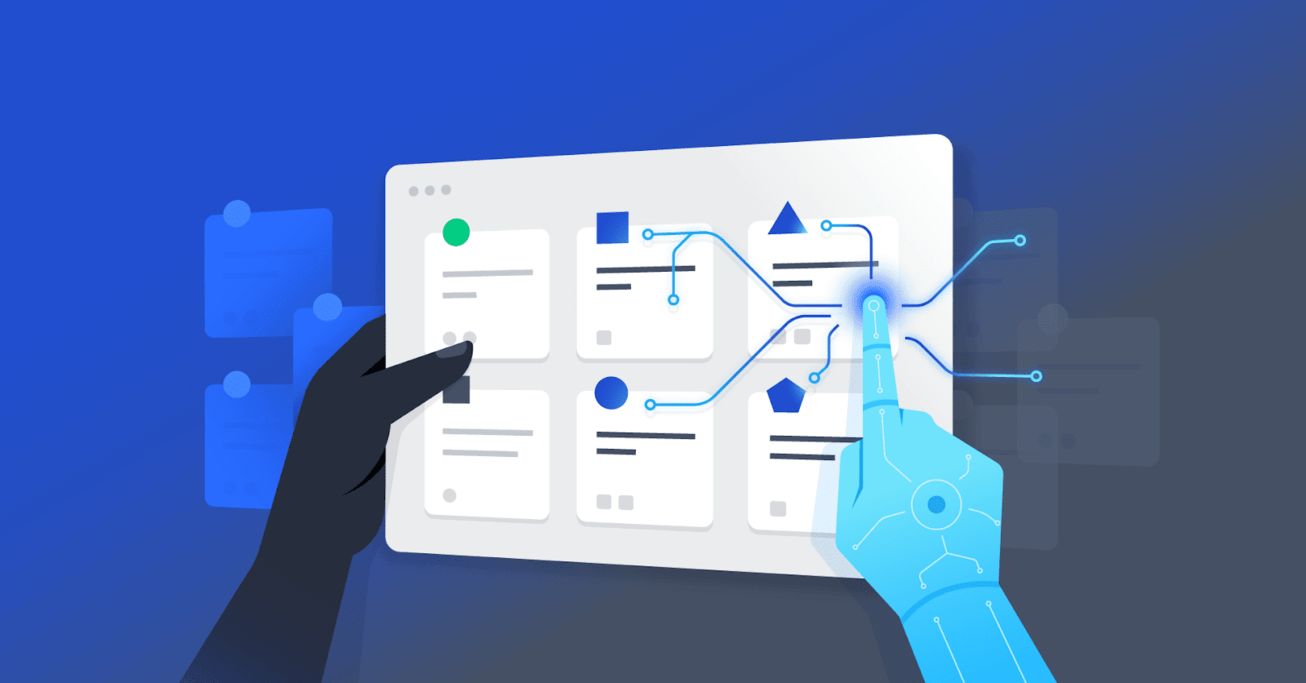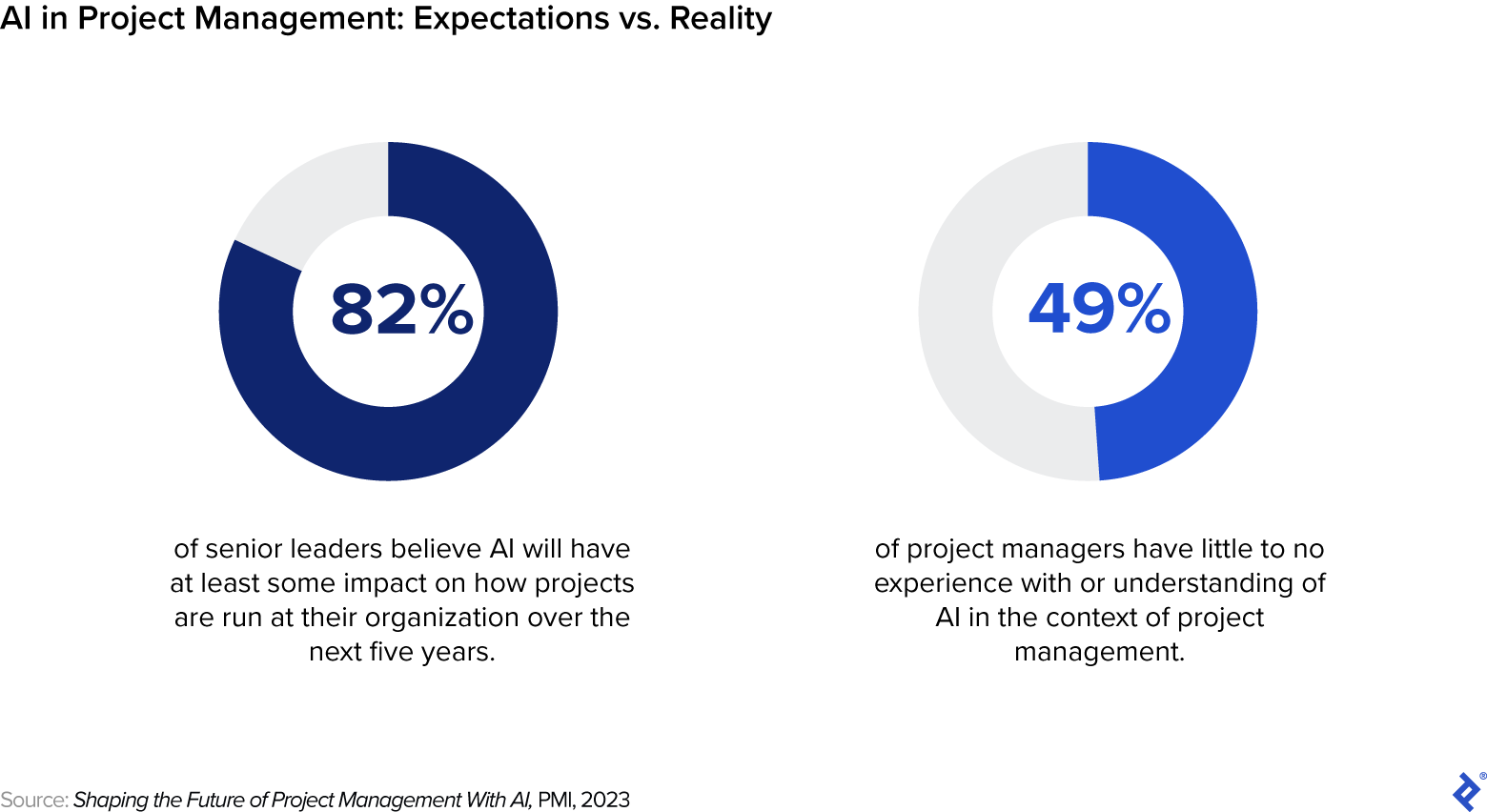Using AI in Project Management: Key Applications and Benefits
When it comes to improving project outcomes, AI holds vast potential, but it can be difficult to know which tools to use and how to apply them effectively. This guide details what you need to know.
When it comes to improving project outcomes, AI holds vast potential, but it can be difficult to know which tools to use and how to apply them effectively. This guide details what you need to know.
Dimiter is a project manager and senior business consultant. He has helped teams at global organizations such as Philips and Hewlett Packard Enterprise solve complex problems using state-of-the-art technology.
Previous Role
CTOPREVIOUSLY AT


Artificial intelligence (AI) is ushering in a new era of efficiency and effectiveness in project management. Project managers whose organizations fully embrace AI are 30% more likely to deliver on time, and 23% more likely to meet or exceed ROI estimates, according to a 2023 PMI survey.
Other recent PMI research found that 82% of senior leaders believe AI will have at least some impact on how projects are run at their organization over the next five years. And yet 49% of project managers have little to no experience with or understanding of AI in the context of project management.
This gap must be closed—and soon. I recently transitioned from managing partner at a small software company to a data leadership position at a company 20 times its size. Improving project delivery and outcomes has been central to both roles—and implementing AI tools has been the primary means of achieving this in both workplaces. AI’s ability to analyze complex data sets, optimize resource allocation, predict potential risks, and automate routine tasks not only contributes to better project execution, but also enables organizations to cultivate an agile mindset that continuously adapts to the ever-changing tech landscape.
So what are the leading applications and benefits of leveraging AI in project management? How can AI augment the project manager’s toolkit? In this article I explore the influence of AI on current project management practices, looking at its key uses and implications for project delivery.
AI and Project Management: Current Applications and Benefits
AI project management tools can be applied in the following areas to achieve more successful project outcomes:
Data Analysis and Predictive Analytics
With the ability to quickly process vast amounts of data, AI empowers project managers to make evidence-based decisions with unprecedented precision. By analyzing historical project data, AI can identify patterns and predict potential project risks.
Imagine running a project that has a similar charter to another project in another country and another language. Pattern identification works despite the language barrier, which means your risk log could be augmented by the risks and mitigation strategies of a project many miles away. This in turn would lead to the reduction of costly delays and budget overruns.
Additionally, project management platforms will one day use AI to automatically generate performance metrics and predictive reports, offering project managers real-time insights into project progress that can enable them to pivot as needed. This is already happening on a small scale with platforms like Asana, Jira, and Azure—either directly or via third-party plugins.
Risk Management
AI technologies are already assisting project managers with risk management in several key ways. By analyzing network traffic patterns and recognizing anomalies that might indicate a security breach, for example, AI can help project managers identify potential cybersecurity threats. This kind of knowledge allows project managers to take proactive steps to mitigate risks, such as implementing security patches or enhanced access controls.
In software development, AI-driven code analysis tools such as Microsoft Copilot, OpenAI Codex, and Amazon CodeWhisperer can assist project managers in identifying code quality issues and potential vulnerabilities early in the development process. Early detection enables project managers to allocate resources effectively, prioritize critical issues, and reduce software defects that could lead to launch problems. It also helps developers deliver functionality more quickly, so that added time can be given to problematic features.
Tools such as Jira, among others, track velocity trends and highlight user stories that may potentially cause delays, allowing project managers to focus on remediation rather than identification—the result is more time spent working on issues and less time spent examining data.
Communication and Collaboration
One significant advancement we’ve seen is the rise of virtual assistants. They can answer common queries, schedule meetings, and provide updates, freeing project managers from administrative tasks so that they can put their energy into higher-value activities. When integrated into communication software such as Slack or Microsoft Teams, virtual assistants can ensure that essential information reaches the right people in a timely manner.
Note-taking tools such as Otter.ai and Rev Online Voice Recorder simplify the process of capturing spoken information, making it more accessible, searchable, and shareable. Project managers can now stop taking notes in real time and instead focus on discussion, guidance, and managing stakeholder expectations. Notes are available immediately after a meeting, so they can be reviewed by participants while the details are still fresh in their minds, rather than waiting until the project manager has the time to edit and share them.
Translation tools are also starting to play a pivotal role in global IT projects by breaking down language barriers. The tools automatically translate messages and documents, meaning project managers can now effortlessly coordinate with team members worldwide, leading to more effective cross-cultural collaboration and knowledge sharing among multinational teams.
Communication can be further enhanced by sentiment analysis tools, which gauge stakeholder engagement and satisfaction by analyzing communication content. Project managers can gain valuable insights and adapt communication strategies accordingly to foster stronger relationships. MonkeyLearn offers free sentiment analysis, which can be used to determine whether investment in a project-management-specific tool would be valuable.
Note taking, data analysis, language translation, and other communication tools powered by AI are helping to dissolve organizational boundaries and ensure that every project is increasingly more efficient than the last, with an outcome that’s more predictable and easier to manage.
AI in Project Management: Challenges and Potential Solutions
Despite the current optimism about—and the significant potential of—AI in project management, the technology also presents challenges that need to be overcome.
Data Availability and Quality
In order to function as it should, AI needs a large set of reliable data points on which it can be trained appropriately. Inaccurate or biased data can lead to flawed predictions, jeopardizing the quality of insights an AI tool can offer.
In a small or recently established organization, project data may be in a reasonably consistent format. But at larger companies that have undertaken thousands of projects the information will likely be fragmented, incomplete, or varied in structure and quality.
Fixing this issue takes time, effort, and investment. You’ll need to engage data engineers or analysts to ensure that the input data is correct, adheres to a minimal quality standard, and is in a format that algorithms can make sense of. Thus, I would recommend that communication or administrative tasks are a good place to start your organization’s first foray into leveraging AI. Functions requiring large, quality data sets, such as analysis or forecasting, ought to come second, once you have more experience with the technology.
Scaled Implementation
While project managers may utilize AI tools on an individual level, scaled impact is harder to achieve. It can only really be reached once processes have been trialed, documented, implemented, and widely adopted. Unfortunately, the learning curve associated with the adoption of new technologies can slow the acceptance of AI in project management. I have found holding introductory training sessions, on both an individual and group basis, to be highly effective in bringing teams up to speed.
Tool Limitations
One of the most critical limitations of AI, both generally and in project management, is its lack of judgment and intuition. Project management “power skills”—those deemed critical to success—are communication, problem-solving, collaborative leadership, and strategic thinking. While AI excels at analyzing data, it does not factor in contextual, emotional, and unforeseen circumstances—all of which are key to complex decision-making, negotiation, and stakeholder management.
The human element is vital in project execution, and it is crucial to be mindful of AI’s limitations when applying it to project management challenges. Tools should be viewed as supportive aids rather than replacing the thought and innovation that project managers exercise and which they foster among their teams.
Resistance to Change
Resisting change is a natural human behavior. Despite a lot of hype and excitement around AI you will no doubt encounter resistance when implementing AI tools—as with any new technology—at your organization. You need to ensure you win hearts and minds first. This tried-and-tested approach is designed to make the change more appealing, and therefore lessen resistance:
- Be clear about which issues you are aiming to tackle with the help of AI and the benefits that will be realized across various functions. Present the solutions and listen to the initial feedback. Consider the root cause of any hesitancy or negativity: Is job security under threat? Is there a technological skills gap? Ensure communication addresses these concerns explicitly (e.g., this AI tool doesn’t mean the business will require fewer project managers).
- Ensure the whole team is familiar with how to use the technology, and if not, conduct training accordingly.
- Pilot an experiment or proof of concept on a single project. Pick a small but highly visible problem—something low stakes that will take minimal effort, but will be impactful enough to gain buy-in. Measure and compare the results of your initial experiment to the baseline and highlight the positive effects.
- Document progress and share the results across the organization. The goal here is to get wide visibility and recognition, showcasing the value that AI tools can add to your project team.
AI Empowers Project Professionals—It Doesn’t Replace Them
We are already seeing the impact that AI tools can have on project management. By streamlining workflows, enhancing cross-functional collaboration, facilitating efficient communication, and reducing the administrative burden, AI tools allow project managers to focus on key human tasks such as decision-making, problem-solving, and stakeholder management.
There are an array of AI tools available, but it’s important to take a strategic approach to implementing and utilizing them in your business. Choose tools that complement existing skills and expertise and be mindful of resistance. Focus initially on improving existing processes and eliminating inefficiencies before taking on more complex projects.
When used appropriately, AI tools can empower project managers, optimize delivery, and improve project outcomes in your business. Now’s the time to get started.
Further Reading on the Toptal Blog:
Understanding the basics
How is AI being used in project management?
AI tools are being applied to these key project management areas: data analysis and predictive analytics, risk management, and communication. AI tools are generating deeper insights, facilitating more efficient collaboration, and allowing automation of administrative tasks.
What are the challenges of AI in project management?
AI adoption in project management has several challenges, including data quality and availability, scaled implementation, tool limitations, and resistance to change. Leaders must be strategic about how they apply AI, focusing on the gradual incorporation of tools that complement skills and improve processes.
How is AI changing the role of project leaders?
AI tools are empowering project leaders by optimizing processes and reducing their administrative burden, allowing them to focus on key tasks that require communication and judgment, such as decision-making, problem-solving, and stakeholder management.
Amsterdam, Netherlands
Member since March 17, 2022
About the author
Dimiter is a project manager and senior business consultant. He has helped teams at global organizations such as Philips and Hewlett Packard Enterprise solve complex problems using state-of-the-art technology.
Previous Role
CTOPREVIOUSLY AT





